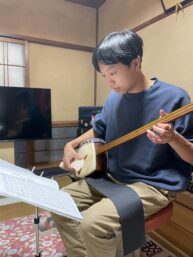
In this CIP I learned all the basics of playing the shamisen, from techniques to repertoire, alongside two other classmates from KCJS. We’d go to the Greenwich House (practice space) twice a week to practice with different groups of relatively older Japanese locals, most of whom had relationships to Iwasaki sensei as students. Learning the shamisen in an environment with a language that I’m not entirely familiar with led to the action of demonstration and common understanding within music to be the biggest teacher of all. I also learned how the power of music can bring people together from various different walks of life, as evidenced by the diversity of people attending Iwasaki sensei’s rehearsals. For future students of Iwasaki sensei, I wouldn’t be worried about making mistakes, as the space is very friendly about giving people a voice through music despite skill level. In fact, in Iwasaki sensei hearing me noodle around on the instrument one day, I was given the opportunity to perform a improvised solo for our final concert.
Our full performance can be found here: https://urldefense.com/v3/__https://www.youtube.com/watch?v=5N9qkeN6lkI__;!!BDUfV1Et5lrpZQ!QEtwNJ5CtYMGkjg0sapTOUV1f9RVug_dUbArsKQoFUmgiGif-0kPvViiBa3M5wjz4VNft1a5TyGyHPFxUWBI0uky$


 This semester I took one-on-one koto lessons under Kurahashi Sensei. For the duration of nine weeks, I took classes once a week with Kurahashi Sensei and learned different techniques and ways to play the koto, while also learning how to play various song with these different methods.
This semester I took one-on-one koto lessons under Kurahashi Sensei. For the duration of nine weeks, I took classes once a week with Kurahashi Sensei and learned different techniques and ways to play the koto, while also learning how to play various song with these different methods.



